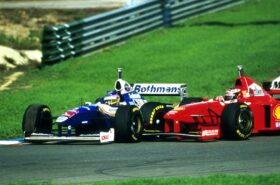Retirement

Michael Schumacher (GER) Ferrari F310B (right) turns into the passing Jacques Villeneuve (CDN) Williams FW19 in a vain attempt to take his Championship rival out of the race. Villeneuve survived to finish third and take the Championship crown; Schumacher retired on the spot and was subsequently stripped of his second place in the Championship.
European Grand Prix, Jerez, Spain, 26 October 1997.
Retirement in Formula 1 grand prix racing refers to the decision made by a driver or a team to withdraw from a race or to end a driver's career. Retirement can occur for various reasons, such as mechanical issues with the car, driver injury, or the decision to retire from the sport altogether.
There are two main types of retirement in Formula 1: voluntary and involuntary. Voluntary retirement occurs when a driver decides to withdraw from a race due to personal or strategic reasons. For example, a driver may choose to retire from a race to avoid risking injury or damage to their car, or because they believe they cannot compete at the same level as their competitors.
Involuntary retirement, on the other hand, occurs when a driver is forced to withdraw from a race due to circumstances beyond their control. This can happen if the car experiences a mechanical failure, if the driver suffers an injury, or if they are disqualified from the race for violating the rules.
Retirement can also refer to a driver's decision to retire from the sport altogether. This decision is often made when a driver feels they can no longer compete at the highest level or when they are no longer able to secure a competitive drive.
When a driver announces their retirement, it often generates significant media attention and can become a major news story. Fans and commentators alike may reflect on the driver's career and achievements, and speculate on who might replace them in the team.
In some cases, retired drivers may continue to play a role in the sport, such as serving as commentators or team principals. Retirement is an inevitable part of Formula 1, but it can also be a bittersweet moment as fans say goodbye to their favorite drivers and welcome new ones to the sport.











LAST 3 F1 Fan COMMENTS